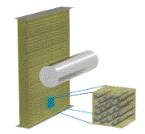Mechanical and Materials Engineering, Department of

Department of Engineering Mechanics: Dissertations, Theses, and Student Research
Date of this Version
3-2012
Document Type
Dissertation
Abstract
Damage and failure in composite materials under dynamic loading has been extensively studied in experiments for several decades. Composite materials exhibit various damage and failure patterns under different loading rates, such as splitting and branching. Classical models cannot directly be applied to problems with discontinuous fields. A new nonlocal continuum model, peridynamics, has been proposed with the goal of solving dynamic fracture problems.
The J-integral has the physical significance of energy flow into the crack tip region. We present a rigorous derivation for the formulation of the J-integral in peridynamics using the crack infinitesimal virtual extension approach. We introduce an algorithm for computing this nonlocal version of the J-integral. Convergence studies are performed and the results converge to the FEM calculations when the nonlocal region goes to zero. We discuss how the boundary conditions and the peridynamic “skin effect” may influence the peridynamic J-integral value. We computationally show the path-independence of the peridynamic J-integral.
A new peridynamic model for unidirectional fiber-reinforced composite is proposed based on a homogenization process. We discretize this model and use it to simulate dynamic brittle fracture and damage in unidirectional fiber-reinforced composites. We analyze dynamic effects induced by different types of dynamic loading on the fracture and damage behavior of such materials. The simulations show that dynamic conditions can lead to co-existence of and transitions between fracture modes, like matrix shattering and splitting cracks. We observe crack migration in the matrix, including crack branching in the matrix similar to what is observed in recent dynamic experiments.
Multilayer glass materials are being investigated for wider use in industry and military. Experimental results of high-velocity impact on multilayer glass show complex patterns of dynamic brittle fracture. We study the damage and fracture of multilayer glass material under impact by using a three-dimensional peridynamic model. Convergence studies are performed in terms of damage patterns and projectile speed profile. The results for the damage patterns at various impact speed, fracture energy, and thickness of glass pate, are compared with available experimental results.
Adviser: Florin Bobaru


Comments
A dissertation Presented to the Faculty of The Graduate College at the University of Nebraska In Partial Fulfillment of Requirements For the Degree of Doctor of Philosophy, Major: Engineering, Under the Supervision of Professor Florin Bobaru. Lincoln, Nebraska: March, 2012
Copyright (c) 2012 Wenke Hu